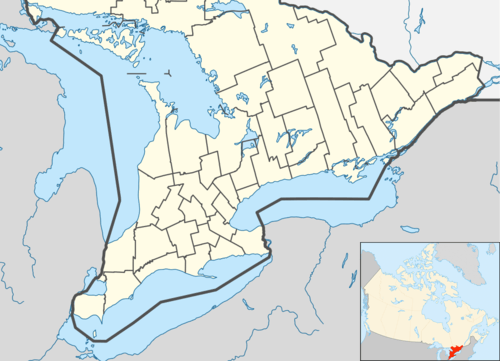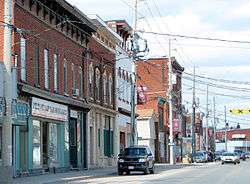Tweed, Ontario
- This page is about the Municipality of Tweed, for the village see Tweed, Ontario (village).
| Tweed | |
|---|---|
| Municipality (lower-tier) | |
| Municipality of Tweed | |
|
Main street in Tweed | |
 Tweed | |
| Coordinates: 44°36′N 77°20′W / 44.600°N 77.333°WCoordinates: 44°36′N 77°20′W / 44.600°N 77.333°W | |
| Country |
|
| Province |
|
| County | Hastings |
| Incorporated | 1998 |
| Government | |
| • Type | Municipality |
| • Reeve | Jo-Anne Albert |
| • Federal riding | Prince Edward—Hastings |
| • Prov. riding | Prince Edward—Hastings |
| Area[1] | |
| • Land | 953.75 km2 (368.24 sq mi) |
| Population (2011)[1] | |
| • Total | 6,057 |
| • Density | 6.4/km2 (17/sq mi) |
| Time zone | EST (UTC-5) |
| • Summer (DST) | EDT (UTC-4) |
| Postal Code | K0K |
| Area code(s) | 613 |
| Website | twp.tweed.on.ca |
Tweed is a municipality and a village located in central-eastern Ontario, Canada, in Hastings County.
The Municipality of Tweed is an amalgamated municipality comprising the former Village of Tweed and the former Townships of Hungerford and Elzevir & Grimsthorpe. The Municipality was incorporated on January 1, 1998, as a lower tier municipality within the County of Hastings two tier governing system.
As of 2004, the total land area was approximately 230,000 acres (930 km²), 30% of which was Crown land. Lakes, rivers and streams account for approximately 4,650 acres (18 km²). There are approximately 600 kilometres (370 mi) of roads throughout the Municipality. The total 2004 property assessment for the Municipality of Tweed was $309,000,000. Its composition was 84% residential, 7% farm, 6% commercial and industrial, and 3% other categories.
Stoco Lake, a part of the Moira River system which borders the town of Tweed, is home to a popular and uncommon sport-fish, the muskellunge or Muskie (Esox masquinongy). The Black River joins the Moira River near the Village of Tweed.
The Canadian Pacific Railway's Havelock Subdivision passed through Tweed to Glen Tay and Smith Falls from the 1880s until the line was abandoned from Glen Tay to Tweed in 1973 then Tweed to Havelock in 1987. A more westerly portion of the line still runs through Peterborough. A Napanee, Tamworth and Quebec Railway (later the Bay of Quinte Railway) had a spur from Tamworth, Ontario to Tweed; the Tweed-Yarker and Tweed-Bannockburn segments were abandoned by 1941 and the former Napanee-Smiths Falls mainline abandoned in the late 1970s.
Communities
- Actinolite
- Bogart
- Buller
- Chapman
- Cosy Cove
- Coulters Hill
- Duff Corners
- East Hungerford 44°30′07″N 77°09′04″W / 44.502°N 77.151°W
- Elzevir
- Farrell Corners 44°27′07″N 77°08′02″W / 44.452°N 77.134°W
- Hungerford
- Larkins
- Lime Lake
- Lodgeroom Corners
- Lost Channel 44°25′08″N 77°18′58″W / 44.419°N 77.316°W
- Marlbank
- Moneymore
- Otter Creek
- Queensborough
- Stoco
- Sulphide
- Thomasburg 44°23′20″N 77°20′45″W / 44.388961°N 77.345896°W [2]
- Tweed
Approximately 30% of the population resides the Village of Tweed, the only urban centre. The remainder of the Municipality consists of five hamlets (Actinolite, Marlbank, Queensborough, Stoco, and Thomasburg) and a large rural area which reaches from Wadsworth Lake in the north to Roslin in the south. The residents of the hamlets and the rural area comprise the other 70% of the population. In 2004, there were approximately 2870 households.
Demographics
| Canada census – Tweed, Ontario community profile | |||
|---|---|---|---|
| 2011 | 2006 | 2001 | |
| Population: | 6057 (7.9% from 2006) | 5614 (0.0% from 2001) | 5612 (-1.6% from 1996) |
| Land area: | 953.75 km2 (368.24 sq mi) | 896.98 km2 (346.33 sq mi) | 896.98 km2 (346.33 sq mi) |
| Population density: | 6.4/km2 (17/sq mi) | 6.3/km2 (16/sq mi) | 6.3/km2 (16/sq mi) |
| Median age: | 44.8 (M: 44.4, F: 45.3) | 41.9 (M: 41.6, F: 42.2) | |
| Total private dwellings: | 2907 | 2709 | 2807 |
| Median household income: | $46,519 | $38,432 | |
| References: 2011[3] 2006[4] 2001[5] | |||
Population trend:[6]
- Population in 2011: 6057
- Population in 2006: 5614
- Population in 2001: 5612
- Population in 1996:
- Elzevir and Grimsthorpe township: 854
- Hungerford township: 3280
- Tweed village: 1572
- Population in 1991:
- Elzevir and Grimsthorpe township: 781
- Hungerford township: 3085
- Tweed village: 1626
Mother tongue:[7]
- English as first language: 95.8%
- French as first language: 0.8%
- English and French as first language: 0.4%
- Other as first language: 3.0%
Forest fire protection history
The Tweed Forest Fire District was founded by the former Ontario Department of Lands and Forests (now the MNR) in 1922 as one of 17 districts to help protect Ontario's forests from fire by early detection from fire towers. The headquarters for the district were housed at Hungerford Road in town. It was the central headquarters for 21 fire lookout towers. When a fire was spotted in the forest a towerman would get the degree bearings from his respective tower and radio back the information to headquarters. When one or more towermen from other towers in the area would also call in their bearings, the forest rangers at headquarters could get a 'triangulation' read and plot the exact location of the fire on their map. This way a team of forest firefighters could be dispatched as soon as possible to get the fire under control. In 1958 the 100-foot (30 m)-tall Hungerford firetower was erected beside the station. However, in the 1970s all the towers had been decommissioned as aerial fire fighting techniques were employed. The Hungerford tower was disassembled in 1996 and placed behind the Tweed Heritage Centre.
Notable stories
- Tweed made national news in 2010 when Colonel Russell Williams, a resident of Ottawa who had a cottage in Tweed, was arrested and accused of the murders of Jessica Lloyd and Corporal Marie-France Comeau. Williams was convicted in 2010 and received two life-sentences for the first degree murders. Williams is in prison in Kingston, Ontario.
- One of Tweed's former claims to fame was that it had the smallest jailhouse in the province. Although its jail (4.9 metres x 6.1 metres) is indeed one of the smallest, other towns in the province have come forward with similar or smaller dimension jails. These include: Berens River, Providence Bay, Ontario, Port Dalhousie, Ontario, Rodney, Ontario, Coboconk and Creemore, Ontario. Today, the Tweed jail has been converted into a community police station.
- In 1996 the town made news when it applied for a CFL team, in an attempt to become the Green Bay of Canada. Had the attempt been successful, the team would have been known as the Tweed Muskies.
- In 1989 the Ottawa branch of the Elvis Sighting Society declared Elvis was alive and well and living in Tweed. For several years after that an Elvis is Alive festival was held in July. Tweed and Elvis made the headlines when a reporter from the Toronto Sun came to investigate if there was truth to the rumours. The only evidence that remains now that Elvis may have ever been in the community is a very short road now called Elvis Lane. Oddly enough not far from the proposed site of the Tweed Muskies stadium. An Elvis festival still takes place every year near the end of August.
- Tweed is the home of IANA Theatre Company, a critically acclaimed producer of original Canadian musical theatre. Founded in 2007, IANA has produced three very successful seasons in Tweed. IANA operates in the Marble Church Arts Centre in Actinolite, a building owned and operated by the Tweed and Area Arts Council. IANA is a professional musical theatre company whose past performers have included Melissa O'Neil (Canadian Idol), David Light (Billy Elliot: National Tour), and Loretta Bailey (Original Canadian Cast of Les Mis) to name a few. Artistic Director Tim Porter was nominated for the Premier's Awards of Ontario for his work with IANA.
See also
References
- 1 2 "Tweed census profile". 2011 Census of Population. Statistics Canada. Retrieved 2012-03-02.
- ↑ Thomasburg, ON, Community Demographics
- ↑ "2011 Community Profiles". Canada 2011 Census. Statistics Canada. July 5, 2013. Retrieved 2012-03-02.
- ↑ "2006 Community Profiles". Canada 2006 Census. Statistics Canada. March 30, 2011. Retrieved 2012-03-02.
- ↑ "2001 Community Profiles". Canada 2001 Census. Statistics Canada. February 17, 2012. Retrieved 2012-03-02.
- ↑ Statistics Canada: 1996, 2001, 2006 census
- ↑ "Clearview, Ontario (Code3543005) (table)". 2006 Census data. Statistics Canada. Retrieved 2010-12-15.
External links
| Wikivoyage has a travel guide for Tweed. |
- Municipality of Tweed
- Tweed Chamber of Commerce
- The Tweed News
- Tweed Heritage Centre
- Tweed Public Library
- IANA Theatre Company
 |
Limerick | Tudor and Cashel (Cashel section) |  | |
| Tudor and Cashel (Tudor section) Madoc Centre Hastings |
|
Addington Highlands Stone Mills | ||
| ||||
| | ||||
| Belleville | Tyendinaga | Greater Napanee |

